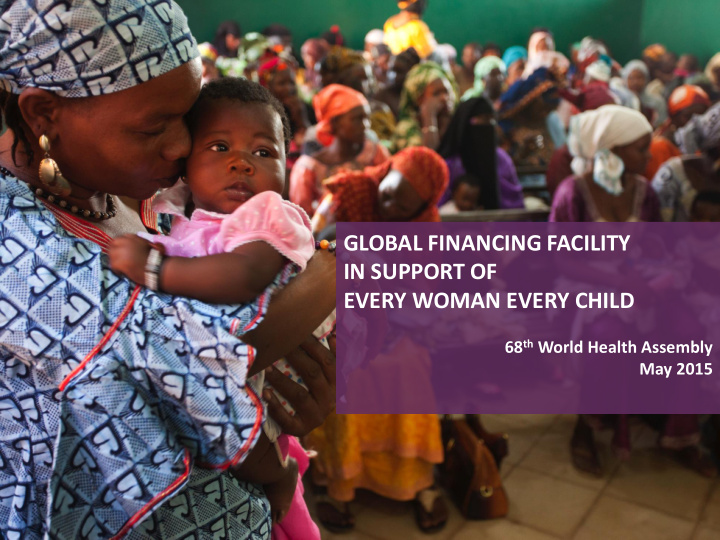



GLOBAL FINANCING FACILITY IN SUPPORT OF EVERY WOMAN EVERY CHILD 68 th World Health Assembly May 2015
The ultimate goal of the GFF is to drive achievement of the SDGs It is the Key Financing Mechanism for the Updated Global Strategy for Women’s, Children’s and Adolescents’ Health To end preventable deaths and improve the quality of life of women, children and adolescents by significantly scaling sustainable investments in RMNCAH Between 2015-2030, scale up in high-burden countries could prevent up to: • 4 million maternal deaths • 101 million child deaths • 21 million stillbirths 2
The GFF: What, How and Who The “what” of the GFF The “how” of the GFF The “who” of the GFF Smart 1. Investment Cases for The Global RMNCAH Financing Facility 2. Mobilization of financing for Results The GFF Investment Cases Trust Scaled 3. Health financing Fund strategies Sustainable 4. Global public goods 4
What: Delivering smart, scaled, sustainable financing for results Focus on evidence-based, high impact interventions and results Smart Results Scaled Finance RMNCAH at scale through Sustainable Maintain RMNCAH significantly results through increased domestic domestic financing and international financing 5
How: Guided by a Country Investment Case High-level vision Diagnosis and prioritization Agree by Consultation Agree on Analyze key obstacle on Investment 2030 results obstacles to results (impact- obtaining (output/outco Case level) results me level) and Core analytics interventions • Looks across clinical service delivery and preventive interventions, health systems strengthening, and multisectoral approaches (including CRVS) • Emphasizes issues (e.g., family planning, nutrition) and target populations (e.g., adolescents) that have been historically underinvested in • Addresses service delivery approaches needed to ensure an 6 efficient national responses
Who: Delivered through a country platform Partners Structures Roles • Not prescriptive about • Preparation and form finalization of • Government • Build on existing structures Investment Case • Civil society (not- while ensuring that these and health for-profit) embody two key financing strategies • Private sector principles: inclusiveness • Complementary • Affected and transparency financing populations • Coordination of • Multilateral and technical assistance bilateral agencies • Diversity in frontrunner and • Technical agencies countries: implementation (H4+ and others) • Ethiopia and Tanzania support used existing structures • Coordination of • Kenya established a new monitoring and national steering evaluation committee 9
The GFF Trust Fund: Catalyzing Investments in RMNCAH • Eligibility – 63 low and lower-middle income countries – Must commit to increasing domestic resource mobilization and using IDA/IBRD for RMNCAH • Resource allocation – Three criteria: need, population, income – $10-60 m per country – CRVS integrated but additional $10 m available if country includes in Investment Case and uses IDA/IBRD • Roll-out – $2.6 b required to reach all 63 countries with an initial 4-year grant: $800 m pledged to date – Four frontrunner countries (DRC, Ethiopia, Kenya, Tanzania) – Additional 10-12 countries to be selected as second phase – Further expansion as resources are mobilized 10
GFF timeline GFF Launch Spring Meetings UNGA Washington, DC World Health GFF Assembly Announcement FfD Conference Geneva Addis Ababa, Ethiopia BUSINESS PLANNING OPERATIONAL PLANNING & SETUP SEP OCT DEC FEB APR MAY JUL SEP 2014 2014 2014 2015 2015 2015 2015 2015 FINANCING COMMITMENTS COUNTRY & STAKEHOLDER CONSULTATIONS 1 st Investors NGO Consultations Group meeting Business Plan Global Strategy 2.0 Launch completed SDG Summit, New York • Process supported by multi-stakeholder Oversight Group & Business Planning Team • 4 frontrunner countries 11
Recommend
More recommend